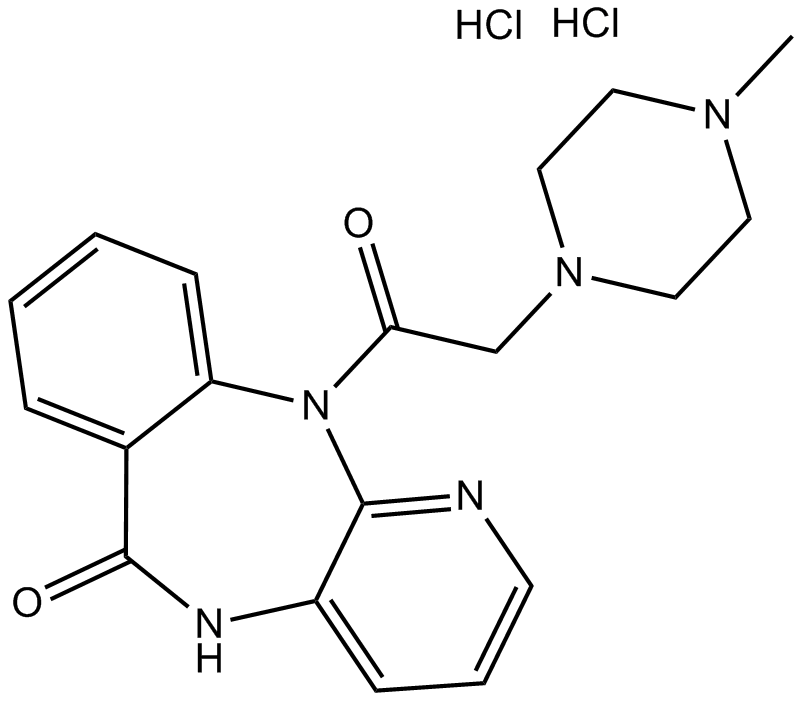Pirenzepine dihydrochloride (Synonyms: Gastrozepin) |
| Catalog No.GC13403 |
M1 muscarinic receptor selective antagonist
Products are for research use only. Not for human use. We do not sell to patients.

Cas No.: 29868-97-1
Sample solution is provided at 25 µL, 10mM.
Pirenzepine dihydrochloride (LS519) is a selective M1 muscarinic receptor antagonist.
The antisecretory properties of pirenzepine on gastric acid and pepsin secretion may be attributed to the antagonistic activity of the drug on muscarinic M1 receptors of gastric intramural plexuses, whereas the effect on parietal muscarinic M2 receptors seems of less importance. Additional inhibitory mechanisms on gastric secretion may be represented by pirenzepine-induced increase in somatostatin release from gastrointestinal system. Significant cytoprotective properties of pirenzepinehave been observed on a variety of experimentally induced peptic ulcerations[1]. Pirenzepine (5-500 μg/mL) inhibits agonist-(acetylcholine-, carbachol- or nicotine-) induced contractions of the toad isolated rectus abdominis muscle, and depresses electrically provoked twitches of the rat phrenic nerve-hemidiaphragm muscle preparation[2].
Pirenzepine is potent in impairing learning of an avoidance; much higher doses are required to antagonize other central muscarinic effects. Pirenzepine is found to impair passive avoidance learning when given i.c.v. 20 min pre-training. The median latencies in pirenzepine-treated animals are 79.5, 11, 27 and 25.5 seconds with doses of 0.03, 0.1, 0.3 and 1 μg per mouse respectively[3]. Acid and pepsin secretion stimulated by either bethanechol or the vagus are inhibited in a dose-responsive manner by pirenzepine[4]. Pirenzepine (5-25 mg/kg i.v.) depresses indirect electrical stimulation-evoked twitches of the cat tibialis anterior and soleus muscle preparations[2].
References:
[1]. Del Tacca M, et al. A selective antimuscarinic agent: pirenzepine. Review of its pharmacologic and clinical properties. Minerva Dietol Gastroenterol. 1989 Jul-Sep;35(3):175-89.
[2]. Ojewole JA, et al. Effects of pirenzepine (Gastrozepin) on skeletal muscle contractility. Methods Find Exp Clin Pharmacol. 1983 Nov;5(9):619-23.
[3]. Caulfield MP, et al. Central administration of the muscarinic receptor subtype-selective antagonist pirenzepine selectively impairs passiveavoidance learning in the mouse. J Pharm Pharmacol. 1983 Feb;35(2):131-2.
[4]. Hirschowitz BI, et al. Effects of pirenzepine and atropine on vagal and cholinergic gastric secretion and gastrin release and on heart rate in the dog. J Pharmacol Exp Ther. 1983 May;225(2):263-8.
Average Rating: 5 (Based on Reviews and 32 reference(s) in Google Scholar.)
GLPBIO products are for RESEARCH USE ONLY. Please make sure your review or question is research based.
Required fields are marked with *




















